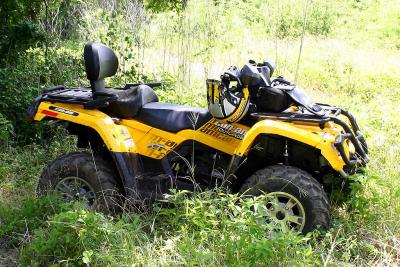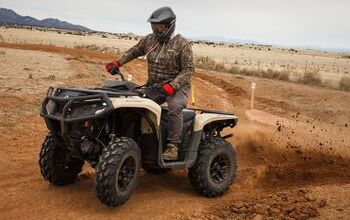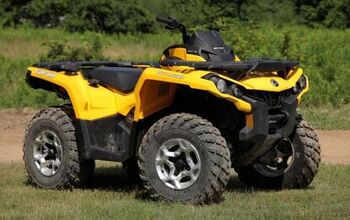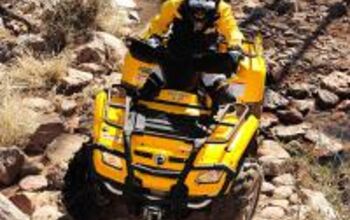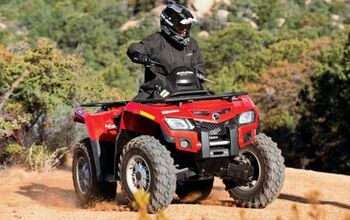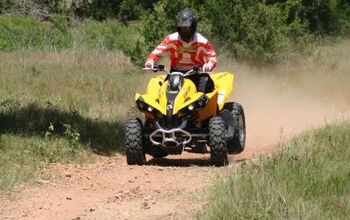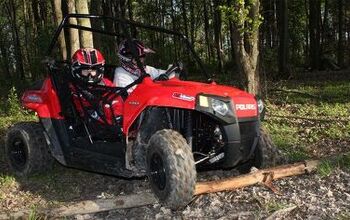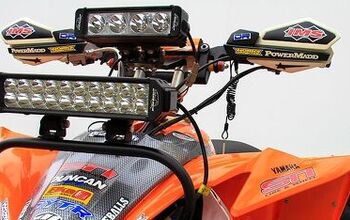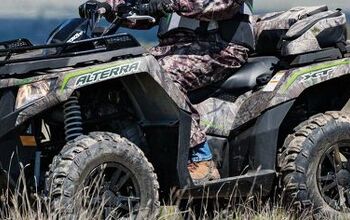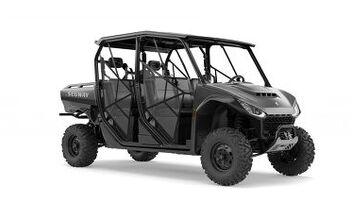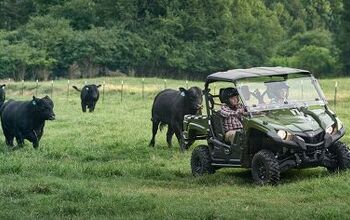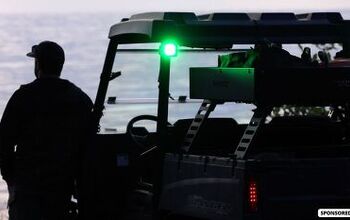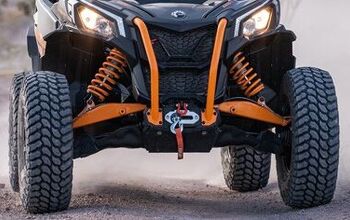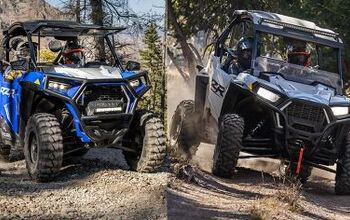2009 Can-Am Outlander 500 MAX EFI Review
Can-Am’s Outlander series offers a wide variation of engine sizes – all of which also support a ‘Max’ model (the two-rider versions).
These are built on a longer frame specially designed to carry the weight of two riders. A stretched axle placement makes it stable under load – particularly while going uphill. The design gives passengers dedicated footrests and comfortable, solid handholds. The slightly elevated seating position also offers clear forward vision over the drivers shoulder. The passenger’s backrest is also designed to move with the motion of the quad, for added comfort.
For example look at the 500 MAX set in the middle of these 2009 offerings (400 to 800R), a market position where this Quad can offer all the features and comforts of the more powerful Max models but at a lower price, thanks to its 500cc engine. But, the 500 is far from anemic; I’d ridden all the models, particularly where the intent is recreational riding with a passenger, and the 500 is more than adequate.
You’ll find you have a lot of extra space if you ride the Outlander MAX solo.
Still if you find yourself riding a MAX solo you can still benefit from that extra space by adding a CRS or Convertible Rack System. This is a cargo system that can be added to the MAX version of any of the Outlanders. By removing the passenger seat, which is done without tools, a rack extension or cargo box can be added in less than a minute. Can-Am offers several other accessories that also fit this space and work with the CRS system. For work or longer tours this is a nice feature. This work or touring feature also compliments the ATV’s ability to tow up to 1,300 lbs, which is a substantial load.
The 500ccc engine in this MAX is a V-Twin configuration with EFI, and a liquid cooled single overhead cam, four-valves per cylinder setup. EFI, in particular, means no choke, and starting is aided by a computer that precisely mixes the right amount of gas and air based on altitude and air temperature. This setup is similar to all the Max engines right up through the new 800R. The key differences are, of course, in power and price.
Each of the Outlander models also uses the same basic chassis components starting with the front suspension that is a MacPherson Strut set-up that is designed to be firm but also soak up rough trail bumps. At the rear is TTI suspension. This Trailing Torsional Independent setup allows each wheel to move independently, but that’s not exactly new. What is new is that the swingarm moves the wheels rearward when the suspension compresses rather than to the side in a pendulum motion. There are three key differences with this system. First, the tire remains in full contact with the ground. Second, it eliminates tire scrub that is bad for stability. Finally, the TTI system has 75% fewer parts than a traditional design. Again these are systems which spill over from the race-built Can-Ams. They are plenty rugged and for riding in rough terrain anything that helps steering, balance and cuts weight is good.
For an extra $1,050, you can get the ‘XT’ version of the MAX, which comes with a winch, wind deflectors, heavy duty front bumper and aluminum rims.
The Max series, with its larger frame, lends itself to add-ons that make touring more comfortable and practical. Several wind deflectors are available as is an XL 3000 winch (made by Warn). A remote control stows in the front storage.
This winch is central to the new Can-Am snow plow system where it is used to electrically lift and drop the blade. While this option can work on the single seat Outlander as well – the longer wheelbase and heavier Max lends itself to this type of application.
There’s plenty of power in the 500cc engine to carry a driver and passenger over just about any terrain.
This plow is available through Can-Am dealers and this year has a new feature – quick attach/release. What this does is let the operator pickup or drop the plow without having to dismount the quad. The push frame on the plow has also been beefed up for ’09 with two-inch (5 cm) diameter springs. The 12-gauge steel blade is also covered in eight layers of powder-coated paint and it’s available in widths of 54, 60 or 66-inches.
The 4WD system on the Outlander is called Visco-Lok and its Can-Am’s answer to the binding that comes from a full-on locked differential. As the name implies it uses oil pressure that is triggered by a spinning wheel to lock up wet clutches. This is completely automatic, so there are no buttons or levers to push or pull. The system tightens up slowly (by mechanical standards) so the transfer of power does not result in wheel hop or driveline clunk. A fact that is important when considering add-ons like the plow.
The XT version of the Outlander MAX 500 comes in yellow, red, black and camo.
This system can transfer as much as 100 per cent of the engines power to whichever wheel has traction. When all wheels are once again turning at the same rpm – the clutch lets go.
Carrying capacities on the Outlander 500 Max are very similar to the larger displacement ATVs. There really isn’t any loss in capacity. For example, the front racks are rated at 100 lbs and 200 lbs in the rear.
Other advantages to the Max series are the availability of items like Camouflage colour schemes for the hook and bullet crowd.
| Can-Am Outlander 500 MAX Specifications | |
| Engine | |
| Engine Type: | 499.6cc, V-twin, liquid-cooled, SOHC, 8-valve (4-valve / cyl) |
| Bore x Stroke: | 82 x 47 mm |
| EFI System: | 46mm Throttle Body, 2 Siemens VDO injectors |
| Starting System: | Electric |
| Transmission: | CVT, sub-transmission with high, low, park, neutral & reverse, Standard Engine braking |
| Drive Train: | Selectable 2w/4w shaft driven with Visco-lok† front differential |
| Dimensions | |
| Length/Width/Height: | 94 x 46 x 45 in |
| Dry weight: | 688 lbs (312 kg) |
| Wheelbase: | 59 in (1,499 mm) |
| Seat Height: | 34.5 in (877 mm) |
| Ground Clearance: | 11 in (279 mm) |
| Towing Capacity: | 1,300 lbs (590 kg) |
| Rack Capacity: | 100 lbs (45 kg) front, 200 lbs (90 kg) rear |
| Storage: | Rear storage 5.3 US gal (20L) CRS (Convertible Rack System) |
| Fuel Capacity: | 5.3 US gal. (20 L) |
| Chassis | |
| Frame: | SST |
| Front Suspension: | McPherson / 7 in. (178 mm) |
| Rear Suspension: | TTI independent / 9 in (229 mm) |
| Front Brakes: | 2 inboard hydraulic discs |
| Rear Brakes: | 1 inboard hydraulic disc |
| Front Tires: | 25 x 8 x 12 in (635 x 203 x 305 mm) |
| Rear Tires: | 25 x 10 x 12 in (635 x 254 x 305 mm) |
| Wheels: | Steel |
| Features | |
| Instrumentation: | Speedometer, tachometer (bar graph RPM, bottom bar numerical RPM), odometer, trip meter, diagnostic center, gear position, hour meter, engine hour meter, 4×4 indicator, temperature and engine lights, fuel gauge, auto shut off after 15 minutes |
| Anti Theft: | D.E.S.S. (Digital Encoded Security System) |
| Electrical: | Prewired for winch |
| Lighting: | 2 fender mounted headlamps (35W) with tail light / brake light |
| DC Outlet: | Lighter type in console, standard connector in the back (15A) |
| MSRP: | $8,349 ($9,399 for XT Package) |
Related Reading:
More by ATV.com Staff




